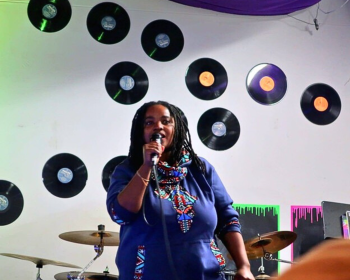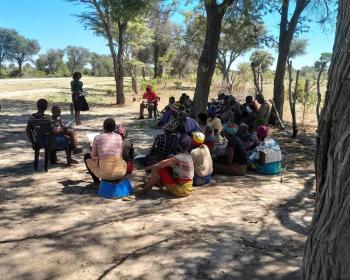The Central Kalahari Game Reserve (CKGR) had its beginnings in 1961 when George Silberbauer, the Bushman Survey officer, convinced the British colonial government of Bechuanaland to set aside some 52,347 square kilometers as a park in which San people and wildlife could coexist. The Central Kalahari is a stark but beautiful landscape of undulating savanna dotted with pans and dissected by fossil river valleys. The resident population of the Reserve consists primarily of G|ui and G||ana, Central Bush-speaking San who have been the subject of many important anthropological studies.
In establishing the Reserve, Silberbauer’s philosophy was not to maintain people in a living museum, but rather to provide people the right of self-determination, a position later to be espoused by the first president of Botswana, Sir Seretse Khama, in 1966, and adopted by the various national development plans over three decades.
At one point the human population of the CKGR was as high as 5,000, but its numbers declined to 1,660 by the mid-1990s as people voluntarily out-migrated for various reasons. Meanwhile the life-ways of those remaining changed as well, with residents supplementing foraging with drought relief food and by keeping goats, donkeys, and horses (but no cattle).
Pressure mounted in the 1990s to regazette the CKGR and free the area of people in favor of diamond mining and high-end tourism. Many protests—national and international—ensued, with a series of interventions by the European Union and other bodies to prevent the removals and preserve the land for the San. The removals took place nonetheless and more than 1,000 San were trucked out of the area and placed into dysfunctional settlements on non-Reserve land. The process did not go smoothly. In 2000, reports in the media documented high rates of arrest for wildlife infractions as well as allegations of harassment and torture by game rangers in the CKGR and other parts of Botswana.
A November 2000 meeting of indigenous groups in Johannesburg, South Africa condemned the Botswana government for these instances of mistreatment and for forced removals dating back to 1997. These criticisms were accompanied by a series of thrusts and parries by a government eager to placate international opinion while pursuing its own agenda. In planning the future of the CKGR, a complex negotiating process has been underway since 1998, with the government across the table from local and regional stakeholders: San non-governmental organizations (NGOs) First Peoples of the Kalahari and WIMSA; the Botswana Christian Council; Ditshwanelo, the Botswana Center for Human Rights; lawyer Glyn Daniels of the Stellenbosch law firm Chennells/Albertyn, which has successfully represented South African San in land claims; and a team of technical advisors led by Arthur Albertson. The San negotiators have the backing of a valuable international ally, the European Union’s (EU’s) Commission on Indigenous Issues.
The recent announcement in international media (September 2001) that a large portion of CKGR land—71 percent—had been restored to the San by the Botswana government was misleading. The government has even now made no decision, except to cut off services to the people remaining in the CKGR in an attempt to force them out. The government’s move effectively precludes the establishment of communal use zones in the CKGR, toward which local legal assistance and NGOs were working. This is the crux of the issue—far more significant than any other, since it concerns recognition of land rights—facing all San in Botswana. If the CKGR goes to resettlement, it is feared that Western Ngamiland and other areas where local and international human rights and development organizations have been pushing for recognition of tenure rights for local people will follow suit.
Recent mapping and occupational and genealogical oral history exercises conducted in aid of San land tenure will do no good if the Botswana government crosses this Rubicon. Nor will the various community trusts and community based natural resource management projects have much future after such an event. After years of living under the threat of having to move from the CKGR, younger people are doing so voluntarily. In mid-October, Aaron Johannes, a San man working for WIMSA, reported that water deliveries had been discontinued, forcing people out of the Reserve.
It is hoped that the government will endorse the CKGR management plan produced by the Department of Wildlife and National Parks. The plan incorporated the findings of community mapping done in the CKGR and has been supported by First Peoples of the Kalahari and international indigenous peoples’ rights advocacy organizations.
Recent (October) Botswana government statements in the local press show that the official refusal of the San’s right to remain in the CKGR is hardening. “We all aspire to Cadillacs,” said Lt. Col. M. Merafhe (now a Minister). “[The San] can no longer be allowed to commune with flora and fauna.”
As of November 2001, only 559 people remained in the Reserve, and the Government of Botswana announced that as of January 2002, provision of water and other services will be made only in existing settlements—that is, in the relocation camps.
Faced with this ultimatum, the CKGR negotiating team in December 2001 brought to the highest levels of government an EU proposal to maintain services for CKGR residents, with the EU taking up primary financial responsibility. The EU, the Botswana government, and the legal team are still in negotiations. (See also page 56.)



